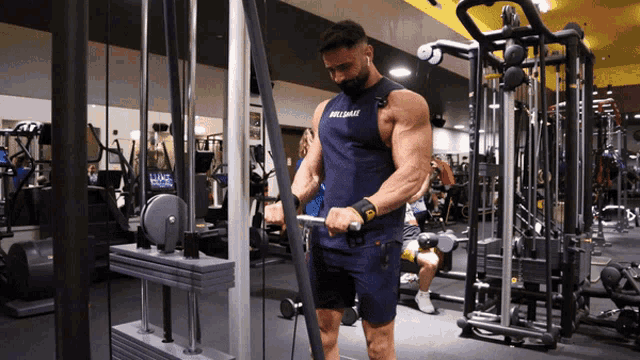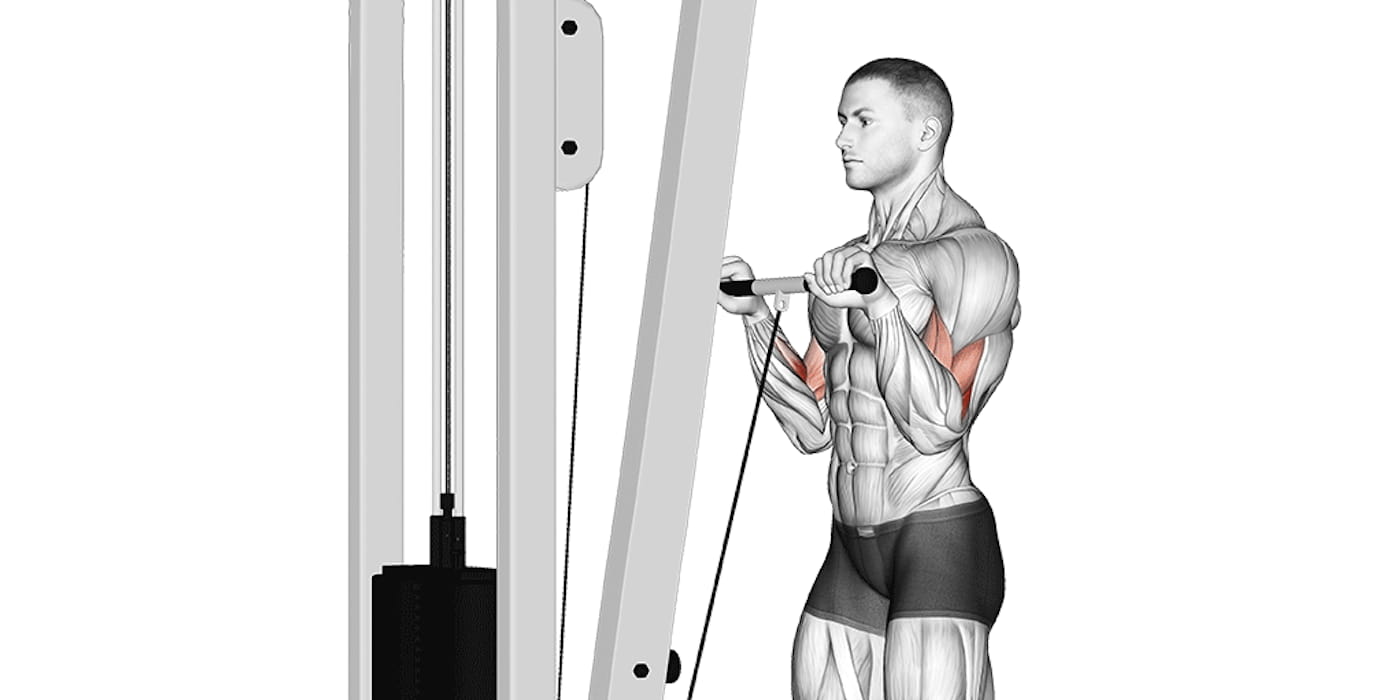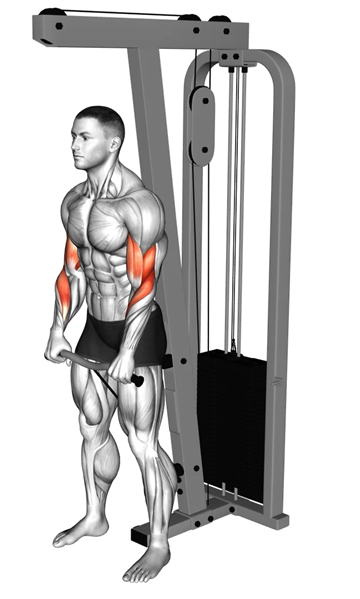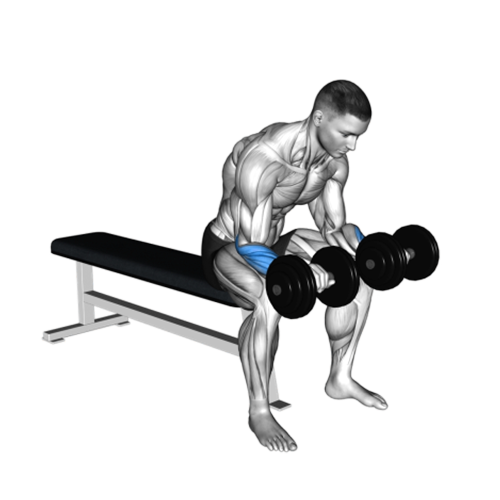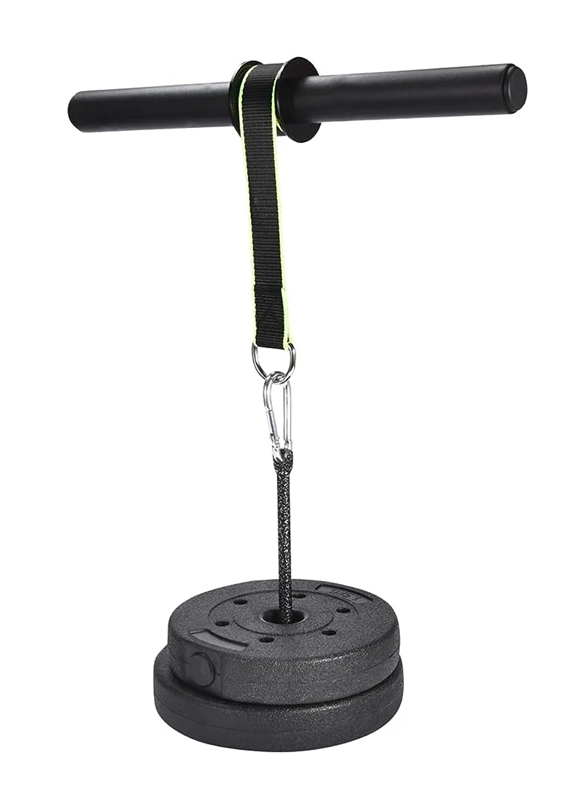Reverse Cable Curl (Overhand Grip, Brachioradialis Focus): Building Forearm Thickness and Functional Strength
If you’ve ever admired the thick, meaty forearms of classic bodybuilders or strongmen, there’s a good chance the brachioradialis — that prominent outer ridge of the upper forearm — caught your attention. It’s the muscle that gives your arms that armored, powerful look even when relaxed.
The Reverse Cable Curl is one of the most effective exercises for developing this area. Unlike the standard bicep curl, this variation uses an overhand (pronated) grip, which shifts the emphasis away from the biceps and directly onto the brachioradialis and wrist extensors.
The cable resistance adds constant tension throughout the entire range of motion, making it an excellent hypertrophy tool for sculpting and strengthening the forearms.
From a bodybuilding standpoint, the Reverse Cable Curl helps create balanced arm development. It builds density and definition in the upper forearms while enhancing grip endurance — a quality that carries over to nearly every compound lift.
Whether you’re an advanced lifter refining your arm detail or a beginner building foundational strength, this exercise deserves a permanent spot in your program.
Muscles Worked
Primary Muscles:
- Brachioradialis – the large forearm muscle responsible for elbow flexion in a pronated position.
- Wrist Extensors – stabilize and control wrist positioning.
Secondary Muscles:
- Biceps Brachii (assisting role)
- Brachialis (underneath the biceps, adds arm thickness)
- Pronator Teres (helps maintain overhand grip stability)
💡 Anatomical Insight:
The brachioradialis originates on the lateral ridge of the humerus and inserts on the distal radius (near the wrist). It’s unique because it flexes the elbow most effectively when the palm faces down — making overhand and hammer-style curls the best way to target it.
Why Bodybuilders Should Use the Reverse Cable Curl
- Develops Forearm Thickness
- Targets the brachioradialis for that dense, outer-forearm look.
- Balances Arm Aesthetics
- Complements bicep and tricep development, creating complete arm symmetry.
- Improves Grip Endurance
- Strengthens wrist extensors and stabilizers, critical for pulling exercises.
- Constant Tension for Growth
- Cable resistance keeps the forearms engaged from start to finish.
- Joint-Friendly Alternative
- The cable’s smooth path reduces elbow and wrist strain compared to barbells.
How to Perform the Reverse Cable Curl
Setup
- Attach a straight bar (or EZ-bar attachment) to the low pulley on a cable machine.
- Stand tall with feet shoulder-width apart and grasp the bar with an overhand (pronated) grip, palms facing down.
- Keep elbows close to your torso and shoulders pulled back slightly.
- Maintain a neutral spine with a slight bend in your knees.
Execution
- Curl Up (Concentric Phase)
- Exhale as you curl the bar upward, flexing at the elbow.
- Focus on driving with your brachioradialis and forearms, not your biceps.
- Keep wrists neutral and rigid — don’t let them bend.
- Raise the bar until your forearms are vertical or just short of the shoulders.
- Lower Under Control (Eccentric Phase)
- Inhale as you slowly extend your arms, resisting the pull of the cable.
- Pause briefly at the bottom before the next rep to maintain full control and tension.
Form Cues
✅ Keep elbows anchored by your sides throughout.
✅ Maintain an overhand grip — no supination at the top.
✅ Control both phases; don’t let the cable pull you down.
✅ Focus on forearm contraction, not shoulder or bicep involvement.
✅ Avoid “rocking” the body or using momentum.
Common Mistakes and Fixes
| Mistake | Problem | Fix |
| Using too much weight | Causes momentum and poor isolation | Use moderate resistance for strict form |
| Bending wrists during curl | Shifts tension to wrists instead of forearms | Keep wrists straight and firm |
| Lifting elbows forward | Engages shoulders and reduces forearm focus | Keep elbows pinned to sides |
| Rushing the eccentric | Misses half the muscle stimulus | Lower under control (2–3 seconds) |
| Partial reps | Limits time under tension | Use full range of motion for best activation |
Programming Guidelines
For Hypertrophy (Forearm Size and Density)
- Sets: 3–4
- Reps: 12–15
- Rest: 45–60 seconds
- Tempo: 2 seconds up, 3 seconds down
For Strength and Power
- Sets: 4–5
- Reps: 8–10
- Rest: 90 seconds
- Focus on heavier loads while keeping strict control.
For Definition and Endurance
- Sets: 3
- Reps: 15–20
- Rest: 30–45 seconds
- Use lighter weight and higher time under tension.
Bodybuilder Training Tips
💪 Mind–Muscle Connection
Think about “lifting with your forearms.” Visualize pulling the bar through the back of your hands.
💪 Slow the Eccentric
The lowering phase is your growth phase — make it last.
💪 Use a Cable Over Barbell Often
Cables provide smoother resistance and are easier on the joints, especially for higher volume work.
💪 Alternate Grip Widths
A slightly narrower grip hits the brachioradialis harder, while a wider grip adds wrist extensor emphasis.
💪 Include in Arm Day or Back Day
Reverse cable curls pair well with bicep curls or as a finisher after back training to reinforce grip strength.
Exercise Variations
- EZ-Bar Reverse Cable Curl
- Reduces wrist strain due to the angled grip.
- Allows heavier loading for hypertrophy.
- Rope Attachment Reverse Curl
- Provides independent wrist motion and allows neutral or pronated grip mix.
- Great for advanced mind–muscle targeting.
- One-Arm Reverse Cable Curl
- Corrects imbalances and deepens the contraction on each side.
- High Cable Reverse Curl
- Performed with cables set at shoulder height.
- Targets forearms from a different angle for added variation.
- Reverse Cable Preacher Curl
- Set up a preacher bench in front of the cable stack.
- Offers incredible isolation and constant tension on the brachioradialis.
Advanced Techniques
- Superset with Standard Cable Curl
- Alternate reverse curls with standard curls to hit both biceps and forearms in one circuit.
- Drop Sets
- Start with moderate-heavy resistance and immediately reduce weight after failure for burnout.
- Slow Negatives
- Take 4–5 seconds to lower each rep — perfect for building density.
- 21s (Partial Reps)
- Perform 7 lower-half reps, 7 top-half reps, and 7 full reps for an insane pump.
- Isometric Hold
- Hold at 90 degrees for 3–5 seconds mid-rep to amplify time under tension.
Sample Arm Finisher (Forearm Emphasis)
- Reverse Cable Curl (Overhand Grip): 3×15
- Cable Wrist Curl: 3×20
- Rope Hammer Curl: 3×12
- Farmer’s Hold: 3×30 seconds
💡 Tip: Keep rest short (30–60 seconds) for maximum forearm pump and endurance stimulation.
Forearm Health and Recovery
⚠️ Warm up wrists with light band curls or rotations before working sets.
⚠️ Stretch extensors and flexors post-workout to prevent stiffness.
⚠️ Don’t overload — focus on volume and control, not maximal weight.
⚠️ Train extensors as much as flexors to prevent overuse injuries.
Integration in a Bodybuilding Split
For complete arm symmetry and performance:
- Arm Day:
- Barbell Curl – 4×10
- Cable Reverse Curl – 3×12–15
- Rope Pushdown – 3×12
- Dumbbell Wrist Curl – 3×20
- Back Day:
- Deadlifts or Rows
- Add 3×15 Reverse Cable Curls as a finisher for grip endurance.
💪 Frequency: 2–3 times weekly for optimal results.
Bodybuilder Insights
- Frank Zane emphasized reverse curls for detail, saying they “complete the forearm, from wrist to elbow.”
- Arnold Schwarzenegger used reverse cable curls as part of his “arm detail” days leading up to competition.
- Chris Bumstead includes them in his off-season for balance and wrist durability during heavy pulling blocks.
These pros understood that forearms frame the entire arm — and the reverse cable curl is one of the sharpest tools for sculpting them.
Strength vs Aesthetic Comparison
| Focus | Load | Reps | Benefit |
| Strength | Moderate-heavy | 8–10 | Grip and extensor power |
| Mass | Moderate | 12–15 | Forearm density and size |
| Definition | Light | 15–20 | Detail, vascularity, endurance |
Practical Takeaways
✅ Keep your grip pronated and wrists rigid.
✅ Focus on control, not momentum.
✅ Include this exercise twice per week for best forearm development.
✅ Pair with standard curls and hammer curls for full arm coverage.
✅ Use cables for joint-friendly, constant tension training.
Conclusion
The Reverse Cable Curl is a small exercise that delivers massive payoff — both visually and functionally. It strengthens the brachioradialis and extensors, builds forearm density, and creates balance between the biceps and lower arm.
The cable’s continuous tension ensures you’re working hard through every inch of the movement, maximizing time under tension and muscle fiber recruitment.
If your goal is complete, aesthetic, and powerful arms, this movement belongs in your rotation.
Train it consistently, focus on perfect form, and over time you’ll develop that armor-plated forearm look that separates casual lifters from true bodybuilders.
Strong grip. Thick forearms. Balanced arms.
That’s the legacy of the Reverse Cable Curl.

